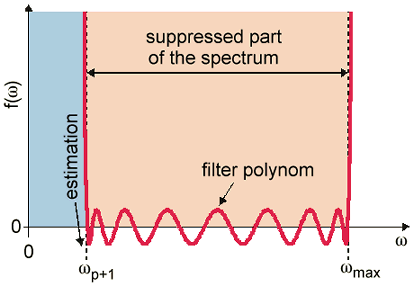



 .
.Which eigenmode solver method to use
Areas of application
electromagnetic field distributions of modes at various frequencies
structure design by using the optimizer or the parameter sweep
external Q-factor calculation
How to start the solver
Before you start the solver you should make all necessary settings. See therefore the Eigenmode Solver Settings Overview. The eigenmode solver can be started from the Eigenmode Solver Parameters dialog box.
How the AKS estimation parameter influences accuracy
The most important parameter for a proper construction of the AKS filter polynomial is a good estimation of the highest eigenmode frequency to be calculated (see diagram).

The highest frequency of the eigenmodes can be estimated automatically if you do not already know the value of this frequency. Therefore the eigenmode solver runs a fast calculation with less points but more modes to get a proper estimation. These fast calculations may be repeated iteratively in order to increase the accuracy of the estimation. This iterative enhancement of the estimation accuracy of the highest frequency of the eigenmodes may also be done if you set the estimation for this frequency manually.
In most cases it is sufficient to use the automatically estimated value to obtain a sufficient good accuracy for the calculated modes. In some cases a better accuracy can also be achieved by increasing the number of iterations up to 5.
Please note that the above mentioned statements do not apply to the JDM eigenmode solver methods, which are parameter free.
Solver logfile
After the solver has finished you can view the
logfile by clicking Post Processing:
Manage Results  Logfile
Logfile ![]() in the main menu. The logfile contains information
about solver settings, mesh summary, solver results and solver statistics.
Under solver results, all calculated modes are listed with their frequency
and the numerical accuracy following the definitions below.
in the main menu. The logfile contains information
about solver settings, mesh summary, solver results and solver statistics.
Under solver results, all calculated modes are listed with their frequency
and the numerical accuracy following the definitions below.
Example:
--------------------------------------------------------------------------------------------
Mode Frequency | Accuracy
| |(Ax-x)/x| max(e) div(e)
--------------------------------------------------------------------------------------------
1 8.02724981695 | 1.51e-013 8.05e-006 2.29e-015
2 10.1781072579 | 8.41e-015 4.94e-006 7.53e-017
3 10.3554337227 | 1.90e-014 5.92e-006 4.23e-016
4 12.5109337728 | 7.97e-015 3.82e-006 2.41e-016
5 14.7562186034 | 2.15e-011 2.33e-006 1.16e-012
--------------------------------------------------------------------------------------------
Definitions:
1. |(Ax-x)/x|: This expression stands for |(A*x - lambda*x)|/|x| which is the relative error in the eigenvalue solution A*x - lambda*x = 0. The norm used is the L2-norm.
2. max(e): The same definition as for 1., but the norm used is the infinity norm.
3. div(e): This gives the remaining divergence of the field by summing up all divergences at the mesh points in the calculation domain.
Unphysical modes
Sometimes a few modes are looking really weird and have a poor accuracy. These are unphysical modes which are basically shifted static solutions including charges. They can easily be identified by a huge divergence error (see solver logfile, div(e)). They do not affect the accuracy of dynamic solutions, you can just ignore them.
See also
Solver Overview, Eigenmode Solver Settings, Eigenmode Solver Parameters, Eigenmode Solver Specials (AKS), Eigenmode Solver Specials (JDM), Eigenmode Solver Specials (Tetrahedral)